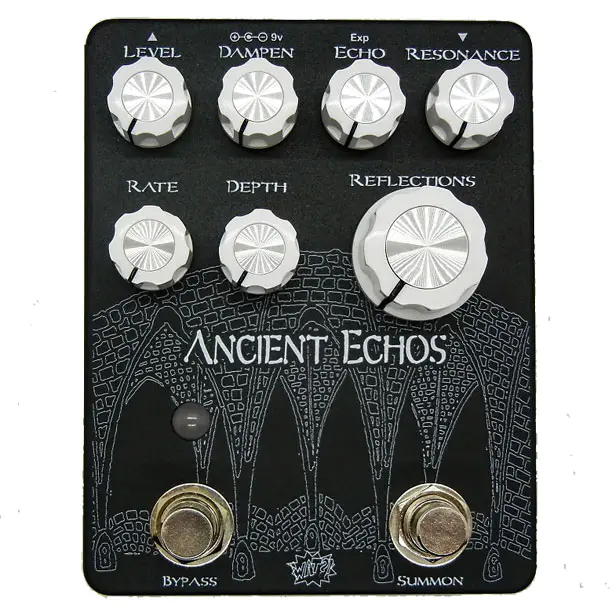
Hailing from California, the Wonderful Audio Ancient Echos is a creative take on ambient reverb + delay.
The pedal’s circuit splits the signal and remixes it a few times between the input and the output jacks, sending it through several effects including echo, modulation, filtering, and a reverb with a range that goes from plate to a gigantic cave.
While the echo and modulation are feeding the reverb, the filter, of the Low Pass kind, is actually placed after it and controlled through the Dampen knob. The Echo knob sets the amount of delay – turn it all the way down for pure reverb.
The Resonance knob doesn’t actually control the filter’s resonance as one may expect, but the depth or size of the reverb, while the bigger Reflections knob – the heart of the circuit – controls the feedback loop within the delay line, and will produce different results depending on the Echo knob position:
Longer Echos will give the reflections a more traditional delay-type of feel, while shorter ones will create a more droning atmospheric ambience.
The Summon footswitch allows you to momentarily turn the Reflection control all the way up with results from the ghostly to the ghastly.
The Rate and Depth knobs control the modulation circuit, which can deliver chorus and vibrato tones.
Part of the dry signal gets reintroduced at the end and mixed with the wet one – although we don’t see a control for blend of mix, so we believe that’s fixed.
Hear the otherwordly sounds of the Wonderful Audio Ancient Echos in the videos below. We added it to our article about the Best Pedals for Ambient and Shoegazer.
Wonderful Audio Ancient Echos, Builder’s Notes
Ancient Echos is a reverb pedal born of the idea that what has been, colors what is now. History can repeat itself and can be leveraged as a powerful tool to create greatness. At its core, Ancient Echos splits your signal in two. One signal passes through to output, enhanced by the input buffer and preamp, while the other signal passes through the rest of circuit. This signal passes through a pre-delay, gets filtered, then splits in two again where part of the signal loops back into the pre-delay circuit to build space and add ambiance to your sound. It is also manipulated by modulation controls, adding gentile sways or sickly swirls to the reverberations. The whole affected signal then passes through a reverb circuit, which can vary from a light plate-style reverb to the sound of vast, cavernous reflections. From there it travels through a low-pass filter and back to mix in with the dry signal.






















